Thank you for joining us at the 2023 Native Plant Sale
Mark your calendars for Saturday, October 5th, 2024!

Mark your calendars for Saturday, October 5th, 2024!
This list is subject to change once final orders are placed. Plants are listed alphabetically by common name. If you have questions, feel free to call us at (206) 842-1216!
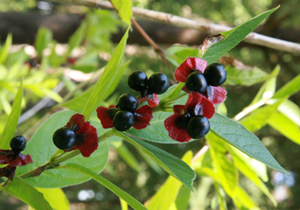
Black Twinberry – Lonicera involucrata
1 gallon – $10
At a Glance: A member of the honeysuckle family this shrub is comprised of slender brown stems with a thin shredding bark. Shrubs usually grow to 5-6 ft tall though occasional specimens can grow up to 10ft tall.
Flowers: paired tubular, yellow flowers with greenish to maroon papery bracts at the base of each pair. Flowers April-July with peak bloom in May
Fruits: Paired dark reddish-black berries surrounded by papery bracts found usually July-September (fruit not consider edible for humans)
Best Growing Conditions: Black twinberries prefer mostly sunny to partial sun and shady sites with moist to wet soils. Ideal for edges of ponds, wetlands, or seasonally wet areas.
Deer Resistant? – Yes
Why Choose Black Twinberry? This shrub is a great for wildlife and does well it seasonal wet sunny areas. The flowers are popular for pollinator insects and hummingbirds and the fruit is a valuable food source for various birds and wildlife.
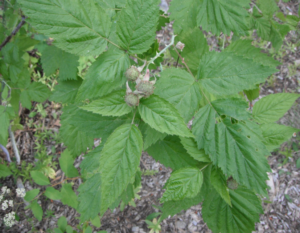 Blackcap Raspberry – Rubus leucodermis
Blackcap Raspberry – Rubus leucodermis
1 gallon – $10
At a Glance: A member of the bramble family, the canes of this vine have distinctive waxy bluish grey stems and covered with small thorns. Leaves usually have 3 sharp-toothed leaflets with white undersides
Growth Form: Cane shrub/vine
Flowers: Flowers are in clusters of 2-7 small white to pink flowers. Blooms May-June
Fruits: The fruits are similar to that of a normal raspberry, about the size of an adult pinky but are of a dark publish black color. Fruit ripens Jul-August
Why Choose Blackcap Raspberry? While not a typical ornamental plant, the tasty fruit produced by this vine is a treat on hot summer days and makes great pies, jams, jellies, and syrups if you can beat the wildlife to the fruit.
Photos: These photos by http://www.nwplants.com are licensed under a Creative Commons Attribution-ShareAlike 3.0 Unported License.
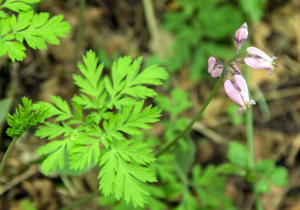 Bleeding Heart – Dicentra formosa
Bleeding Heart – Dicentra formosa
1 gallon – $10
At a Glance: a 12”-18” tall perennial with clusters of delicate pink flowers that appear in late April
Flowers: delicate pin, heart-shaped flowers dangle on long stems
Fruits: Shiny pod-like black capsules with multiple seeds inside.
Best Growing Conditions: Bleeding Heart likes shady, moist areas and makes an excellent understory plant
Deer Resistant? – Yes
Why Choose Bleeding Heart? This herbaceous perennial remains in flower all through spring and summer. The “nectar-filled blooms” attract hummingbirds and bumblebees and it is an excellent woodland species that grows well with fringe cup and wild ginger. The leaves are eaten by Parnassius clodius butterfly larvae.
Photos: © Paul Brians
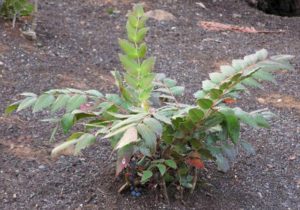 Cascade Oregon grape – Mahonia nervosa
Cascade Oregon grape – Mahonia nervosa
1 gallon – $10
At a Glance: Low-growing, creeping shrub with dark green holly-like leaves and slender spikes of yellow flowers.
Height: Up to 2 feet tall.
Leaves: Leaves are in long clusters with numerous dark green, glossy, holly-like leaves
Flowers: Small bright yellow flowers in elongated clusters at tops of stems appear in early spring
Fruits: Small rounded dark blue berries with a whitish bloom.
Best Growing Conditions: Partly sunny to full shade; moist to dry soil.
Deer Resistant? – Yes
Why Choose Cascade Oregon Grape? A slower-growing deer resistant species, it is especially well-suited to areas of dry shade, providing an attractive anchor for the border of a shady garden or pollinator garden. Ideal as a low maintenance ground cover or low hedge and is drought resistant once established. One of the most common understory plants in the Pacific Northwest, various species of birds and mammals prefer the small berries produced by M. nervosa.
Description courtesy of http://www.wnps.org and www.portlandnursery.com
Photo courtesy of DHochmayr || CC-BY-SA-3.0 and http://www.nwplants.com, licensed under a Creative Commons Attribution-ShareAlike 3.0 Unported License.
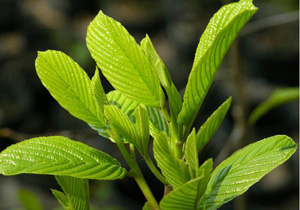 Cascara – Rhamnus purshiana
Cascara – Rhamnus purshiana
1 gallon – $10
At a Glance: Erect, tall shrub or small tree with alternate leaves and inconspicuous flower clusters, can grow up to 33ft tall
Leaves: egg-shaped to oblong, deciduous, dark glossy green, 6-12 cm (2.5-5 in) long, finely toothed, strongly pinnately veined in furrows, the surface washboardy
Flowers: Small umbrella-shaped clusters of greenish yellow flowers appear in April and May
Fruits: Blue black to purplish-black berries, 5-8 mm across; edible
Best Growing Conditions: tolerates wet, moist, or dry soils in partial sun to partial shade
Why Choose Cascara? This mid-story tree grows well in small gaps of sunlight under an established tree canopy, or at forest edges. The leaves and other plant parts are a food source for a range of butterfly larvae. Cascara bark can be used to make a strong laxative, and was harvested on Bainbridge Island for many years in the early 1900s to help supply the national market.
Photos: Photos by http://www.nwplants.com are licensed under a Creative Commons Attribution-ShareAlike 3.0 Unported License.
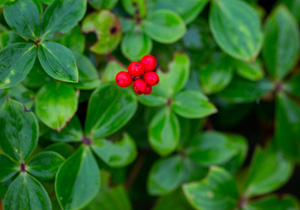 Creeping Dogwood – Cornus canadensis
Creeping Dogwood – Cornus canadensis
1 gal – $10
At a Glance: Deciduous Groundcover. This wonderful groundcover prefers light shade and a nice organic soil. Attributes include attractive foliage, edible berries, beautiful white blooms, spreads slowly.
Height: Up to 1 ft.
Growing Difficulty: High
Best Growing Conditions: Moist, organic soil, partial to full shade. Many gardeners place rotting wood at the bottom of the planting hole to provide suitable nutrients to thrive.
Best Companions: Ferns, other moist-woods inhabitants
Why Choose Creeping Dogwood? Lovely and pristine, it is like a jewel in the shade or woodland garden. In the lives of gardeners there are some plants that are so beautiful and special that they are worth the extra effort they may take to establish or care for; can be forgiven their idiosyncrasies and neediness in the face of the simple pleasure they bring. Cornus canadensis should be high on this list. (Portland Nursery)
Description courtesy of www.kingcounty.gov/gonative
Photo © 2019 Sue Larkin
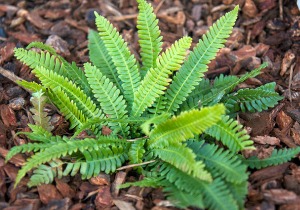 Deer fern – blechnum spicant
Deer fern – blechnum spicant
1 gallon – $10
At a Glance: Dark green fern leaves grow in tufts from short, stout rhizomes.
Height: Up to 40 in.
Leaves: Narrow, dark, glossy leaf with a wavy, crinkled edge along the leaf; the stalk is gloss black. Upright “flowering” stalks emerge from the center of the fern’s base.
Best Growing Conditions: Deep shade and some moisture; plants in sun tend to grow smaller.
Best Companions: Other woodland natives, such as Trillium ovatum (Western Trillium), Achlys triphylla (Vanilla Leaf), or other ferns.
Deer Resistant? – Yes
Why Choose Deer Fern? If you are looking for an elegant addition to your shade garden, you could not do better than to plant Deer Fern. Its dark green, shiny, leathery fronds and purple-black stems making this a standout among the ferns. (WNPS)
Photo © Peggy A. Lopipero-Longmo from www.flickr.com (License)
Descriptions courtesy Washington Native Plant Society
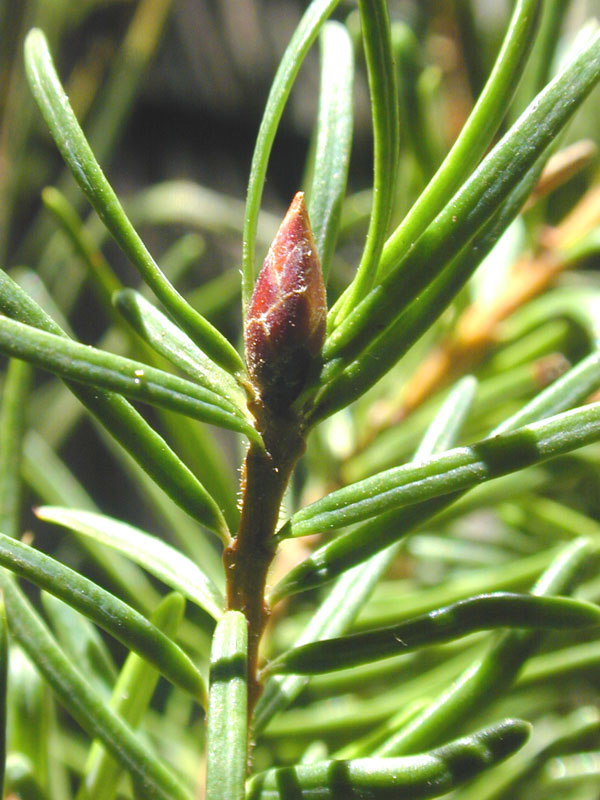 Douglas Fir – Pseudotsuga menziesii
Douglas Fir – Pseudotsuga menziesii
1 gallon – $10
At a Glance: Needles 2-3 cm long with pointed tips; produces reddish-brown pollen cones.
Height: Up to 300 feet
Best Growing Conditions: Full sun/mostly sunny with moist/dry soil.
Photo: Douglas fir (Pseudotsuga menziesii) branch close up. Taken by Eric Guiinther and released under the GNU Free Documentation License
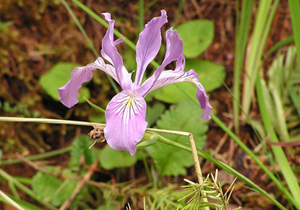 Douglas Iris – Iris douglasiana
Douglas Iris – Iris douglasiana
1 gallon – $10
At A Glance: The rhizomes spread slowly, eventually creating a 2-4 ft. wide clump. Tufts of 1-2 ft., sword-shaped, dark-evergreen leaves arise from the rhizome and surround a flowering stalk of equal height. Several showy iris blossoms emerge from leafy bracts atop the stalks.
Height: 1-2′ tall with a 3″ flower
Flowers: Flower color ranges from light blue-violet to dark purple, occasionally white.
Best Growing Conditions: Part sun to full shade
Deer Resistant? – Yes
Why Choose Douglas Iris? Being easy to grow and extremely long-lived (clumps have been found in the wild that are over 100 years old), the Douglas Iris should be in every native plant garden. Birds and butterflies will flock to this plant, a perfect choice for the garden in partial shade.
Photos by http://www.nwplants.com are licensed under a Creative Commons Attribution-ShareAlike 3.0 Unported License.
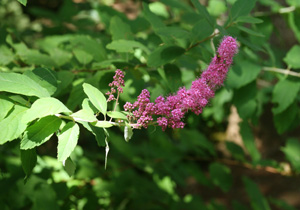 Douglas spirea – Spirea douglasii
Douglas spirea – Spirea douglasii
4″ pot – $5
At a Glance: A moderate height multi stemmed wetland shrub with dark green leaves ideal for rain gardens or to attract pollinators to a property.
Height: Grows 3-6ft tall
Leaves: Oblong to oval leaves that are toothed at the middle, almost as though something at the tip of the leaf
Flowers: Small purplish-pink flowers that grow in dense clusters or upright plumes. Flowers from May-July
Best Growing Conditions: Prefers full sun to part sun sites with wet to moist soils though it can grow in areas that only get seasonally wet make it relatively drought tolerant,
Why Choose Douglas spirea? A must have for wet pollinator garden or rain garden. The plumes of pink flowers are often covered with bees, hummingbirds, and other pollinators during the flowering season. The shrub grows best in clumps so be sure to buy at least two. Once established the spirea will spread via both seed and rhizomes. They can get a bit aggressive and take over an area without care though the “sea of pink” they create when in bloom makes it worth it.
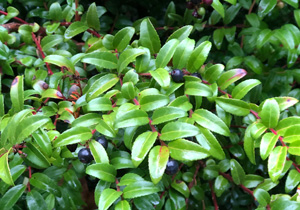 Evergreen Huckleberry – Vaccinium ovatum
Evergreen Huckleberry – Vaccinium ovatum
1 gallon – $10
At a Glance: Beautiful foliage and edible fruit make this a must in most gardens; the new growth is bronze and the berries are blue to black; does not transplant well, but can be grown easily from smaller potted stock; can be hedged.
Height: Up to 12 ft.
Best Growing Conditions: Dry to moist soil, partial to full shade
Flowering Period: Showy flowers appear April to May
Deer Resistant? – Yes
Why Choose Evergreen Huckleberry? A favorite of local wildlife, the berries are consumed by many species of birds and mammals while the shrub itself is deer resistant. The flowers attract a variety of butterflies as well as hummingbirds. The fruits can also be used for jams or in cooking, and are rich in vitamin C.
Description courtesy of www.kingcounty.gov/gonative and http://www.nwplants.com.
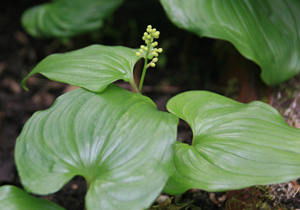 False Lily of the Valley – Maianthemum dilatatum
False Lily of the Valley – Maianthemum dilatatum
4″ – $5
At a glance:Perennial ground cover, stems erect, often in clumps from creeping roots. Leaves heart-shaped, up to 8 in. long by 4 in. wide, shiny. Flowers fragrant, white, many in cone-shaped cluster topping stem above leaves.
Height: Up to 1 ft.
Flowering Period: Late Spring
Best Growing Conditions: Moist soil, partial to full shade
Why Choose False Lily of the Valley? A beautiful, dense groundcover producing delicate white flowers, and the berries that follow are enjoyed by a wide array of wildlife including small mammals and birds.
Description courtesy of kingcounty.gov/GoNative
Photo ©2007 Walter Siegmund || CC-BY-SA-3.0
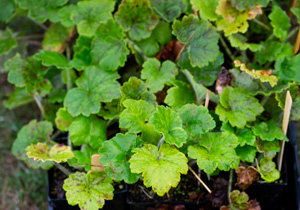 Fringecup – Tellima grandiflora
Fringecup – Tellima grandiflora
4″ pot – $5
At A Glance: Attractive, fuzzy heart shaped leaves, spikes of greenish-white to reddish flowers. Slug resistant. Occasionally will spread aggressively. Evergreen during mild winters.
Height: Up to 1 ft
Flowering Period: April – July
Best Growing Conditions: Partial sun to full shade, moist soil
Deer Resistant? – Yes
Why Choose Fringecup? Fringecup makes an excellent ground cover as it spreads easily and looks fabulous en masse, and hummingbirds will thank you for the sweet nectar. The flower stems add height and an airy quality to composed flower bouquets. They are long lasting as well.
Photo © 2019 Sue Larkin
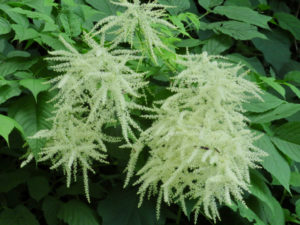
Goatsbeard – Aruncus dioicus
4″ pot – $5
At a Glance: A robust perennial with compounded toothed leaves short stout creeping rhizomes.
Height: 3-5 ft tall
Flowers: Large feathery clusters of small white flowers on branch like spikes. Male and female flowers on separate plants witht he male plants having showier flowers. Peak bloom May-June
Best Growing Conditions: Prefers moist to wet soils and tolerates seasonal flooding. Can grow in sunny, part shade, and shaddy sites.
Deer Resistant? – Yes
Why Choose Goatsbeard? An ideal plant for large scale displays of white blooms or in pollinator gardens, this species was also once a widely used medicinal plant by multiple tribes in the Pacific Northwest to treat a variety of medical issues including stubborn sores, colds, sore throats, and swelling to name a few.
Photo copyright by Thomas Muller
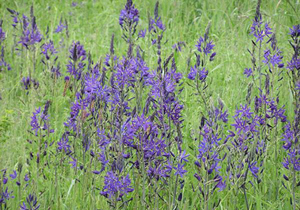 Great Camas – Camassia leitchlinii
Great Camas – Camassia leitchlinii
4″ pot – $5
At a Glance: Stately perennial from a deep bulb, producing spikes of large blue flowers in early spring.
Height: Up to 28 inches (70 cm)
Flowers: Five or more deep blue (rarely white) flowers in a long terminal spike; size: 3.5 cm (1.4 in) long.
Flowering Period: April, May.
Best Growing Conditions: Full sun, moist to dry soil
Why Choose Great Camas? A true meadow plant, this Camas likes moisture in the winter and spring followed by a dry period in the summer. Camas will do well in sun or filtered shade and succeeds in heavy soils.
Photos by http://www.nwplants.com are licensed under a Creative Commons Attribution-ShareAlike 3.0 Unported License.
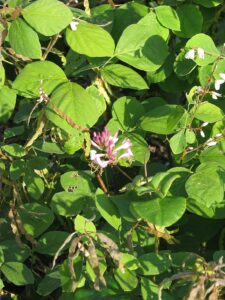 Hairy Honeysuckle – Lonicera hispidula
Hairy Honeysuckle – Lonicera hispidula
1 gallon pot – $10
At a Glance: Vine; oval-shaped leaves; dark green leaves; tubular flowers 1-2 cm long; pinkish-purple flowers
Height: Up to 33 feet.
Flowers: Tubular pinkish-purple flowers 1-2 cm long.
Flowering Period: May, June, July
Best Growing Conditions: Full sun/mostly sunny. Dry soil.
Why Choose Hairy Honeysuckle? Attractive flowers and a great pollinator.
Photos by http://www.nwplants.com are licensed under a Creative Commons Attribution-ShareAlike 3.0 Unported License.
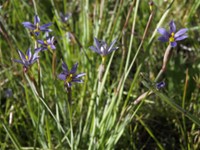 Idaho Blue-Eyed Grass – Sisyrinchium idahoense
Idaho Blue-Eyed Grass – Sisyrinchium idahoense
4″ pot – $5
At a Glance: Mostly basal leaves; long and narrow; blue to bluish-purple flower; flowers in March, April, May, and June.
Height: Up to 28 inches tall.
Best Growing Conditions: Full sun/mostly sunny and wet/moist soil.
Photo by Jim Morefield from Nevada, USA
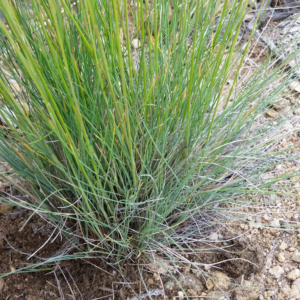 IDAHO FESCUE – Festuca Idahoensis
IDAHO FESCUE – Festuca Idahoensis
At A Glance: Cool-season bunchgrass that grows well once established
Height: 11 – 39 inches
Diameter/Clump Size: 12 – 20 inches
Leaves: Delicate, narrow, gray green to bluish green leaves with rolled edges
Flowers: Yellow flowers that bloom spring to mid-summer
Best Growing Conditions: Prefers open, drier areas or well-draining, rocky soil
Why choose Idaho Fescue Good wildlife forage that can withstand grazing. Fine, fibrous, deep roots help control erosion and improve soil structure.
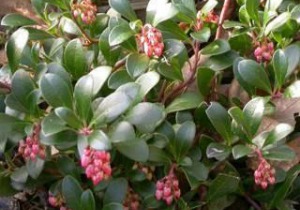 KINNIKINNICK – Arctostaphylos uva-ursi
KINNIKINNICK – Arctostaphylos uva-ursi
4″ pot – $5
At a Glance: A mat-forming evergreen shrub producing lovely pink flowers that later turn into red berries. The velvety red-brownish branches are long, flexible and rooting. Pure stands of kinnikinnick can grow to be very dense.
Height: Up to 8 inches tall.
Leaves: Oval in shape, dark green, shiny above and paler beneath with a leathery texture; up to 3 cm long.
Flowers: Small pink bell-shaped flowers in few-flowered drooping terminal clusters; size: 5 mm long. Flowers emerge in March, April.
Fruits: Kinnikinnick berries are called drupes and ripen late, continuing to stay on plants into winter.
Best Growing Conditions: Sandy and well-drained exposed soil, dry rocky slopes
Deer Resistant? – Yes
Why Choose Kinnickinnick? This is a great alternative to the dreaded English ivy! Have a place you hate to mow? A boring parking strip? A retaining wall or rockery that could use a cascade of green? Kinnikinnick is a great choice. It’s low maintenance, drought tolerant, and a pal to birds (like grosbeaks and hummingbirds) and insects (like bees and butterflies), providing sustenance long into the lean season of winter.
Description courtesy of Washington Native Plant Society http://www.wnps.org/landscaping/documents/Kinnikinnick.pdf
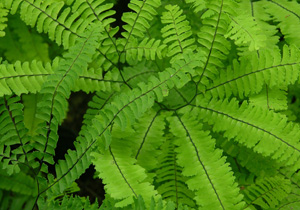 Maidenhair Fern – Adiantum pedatum
Maidenhair Fern – Adiantum pedatum
1 gallon – $10
At a Glance: Small to medium-sized delicate, deciduous fern with a fan-shaped arrangement of five to seven fingerlike branchlets each bearing many toothed leaflets.
Height: 1-2 feet
Leaves: Light to bright green, 10-40 cm (4-16 in) across
Best Growing Conditions: Partial sun to full shade, moist soil.
Deer Resistant? – Yes
Why Choose Maidenhair Fern? The Maidenhair Fern grows in moist and shaded crevices in rocks, especially near falling or rushing water, where the plant benefits from the constant mist. More tender than some of the other northwest native ferns, the beauty of this unique plant lends itself to small vignettes in company with other woodland natives.
Photos and description by http://www.nwplants.com are licensed under a Creative Commons Attribution-ShareAlike 3.0 Unported License.
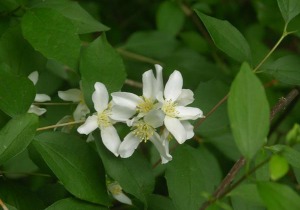 Mock Orange – Philadelphus lewisii
Mock Orange – Philadelphus lewisii
1 gallon – $10
At a Glance: Erect, loosely branched shrub with large fragrant white flowers.
Height: Up to 10 feet.
Leaves: 3-5 cm (1-2 in) long; green in color
Flowers: 4 petals; numerous stamens; 3-15 in clusters at the end of lateral branches. Fragrant, appear May – July
Best Growing Conditions: Full sun to moderate shade in moist, well-drained soils.
Deer Resistant? – Yes
Why Choose Mock Orange? Nectar attracts pollinator species such as hummingbirds and insects, while the seeds are consumed by various birds and mammals. Large, showy, and fragrant blooms make them excellent for ornamental purposes and are attractive in hedgerows.
Photos courtesy of http://www.nwplants.com are licensed under a Creative Commons Attribution-ShareAlike 3.0 Unported License.
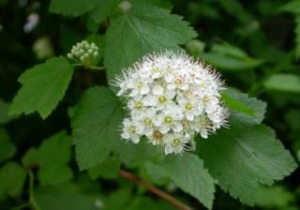 Ninebark – Physocarpos capitatus
Ninebark – Physocarpos capitatus
1 gallon – $10
At a Glance: Erect to spreading shrub up to 4 meters tall with clusters of white flowers.
Height: Up to 13 feet (4 meters).
Growth Form: Shrub.
Stems: Brown shredding peeling bark.
Flowers: White, small, 5 petals, about 30 pink stamens; several to many in terminal, rounded clusters. Peak bloom May – June.
Best Growing Conditions: Moist or wet soils in full sun to part shade. Forest edges, wetland edges, thickets, riparian corridors.
Deer Resistant? – Yes
Why Choose Ninebark? Persistent seed heads provide a food source for birds well into the winter. Once established, root systems are excellent at holding soil.
Photo courtesy of the Washington Native Plant Society / Starflower Foundation Image Herbarium.
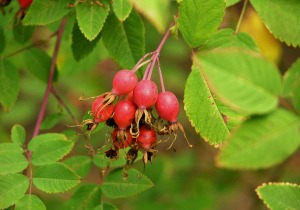 Nootka Rose – Rosa nutkana
Nootka Rose – Rosa nutkana
1 gallon – $10
At a Glance: Spreading shrub with a pair of prickles at the base of each leaf and large pink rose flowers.
Height: Up to 10 feet.
Flowers: Large, primarily pink flower borne singly or in pairs of 2-3 at the branch tips, appear through May and June.
Fruits: Round, purplish-red rosehips, 1-2 cm across
Best Growing Conditions: Mostly sunny; moist – dry soil. Nootka rose is tolerant of a very wide range of conditions.
Why Choose Nootka Rose? Pollen-seeking bees are attracted to this beautiful shrub, and the rosehips remain on the plant throughout winter, providing food for small mammals, birds, and insects.
Photos courtesy of http://www.nwplants.com are licensed under a Creative Commons Attribution-ShareAlike 3.0 Unported License.
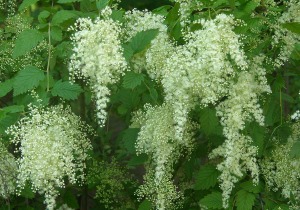 Oceanspray – Holodiscus discolor
Oceanspray – Holodiscus discolor
1gallon – $10
At a Glance: An erect, typically multi stemmed, hardy drought tolerant flowering shrub with a faintly sweet sugary scent when in bloom
Flowers: When in bloom, the plant has multiple dense lilac-like flower clusters comprised of a multitude of small white to cream color flowers
Best Growing Conditions: Prefers dry to moist soils with shade to part shade
Deer Resistant? – Yes
Why Choose Oceanspray? This plant is ideal for the lazy gardener, needing almost no watering once established and only infrequent pruning if a “manicured” appearance is desired. It is ideal for hedges or pollinator gardens with its dense flower profusions.
The shrub is also known for the hardness and strength of its wood being regularly used for digging sticks, spears and harpoon shafts, bows and arrows shafts by nearly all coastal tribes and used as a medicinal plant as well by many of them. Wooden pegs made from shrub have been used as a nail alternative in construction.
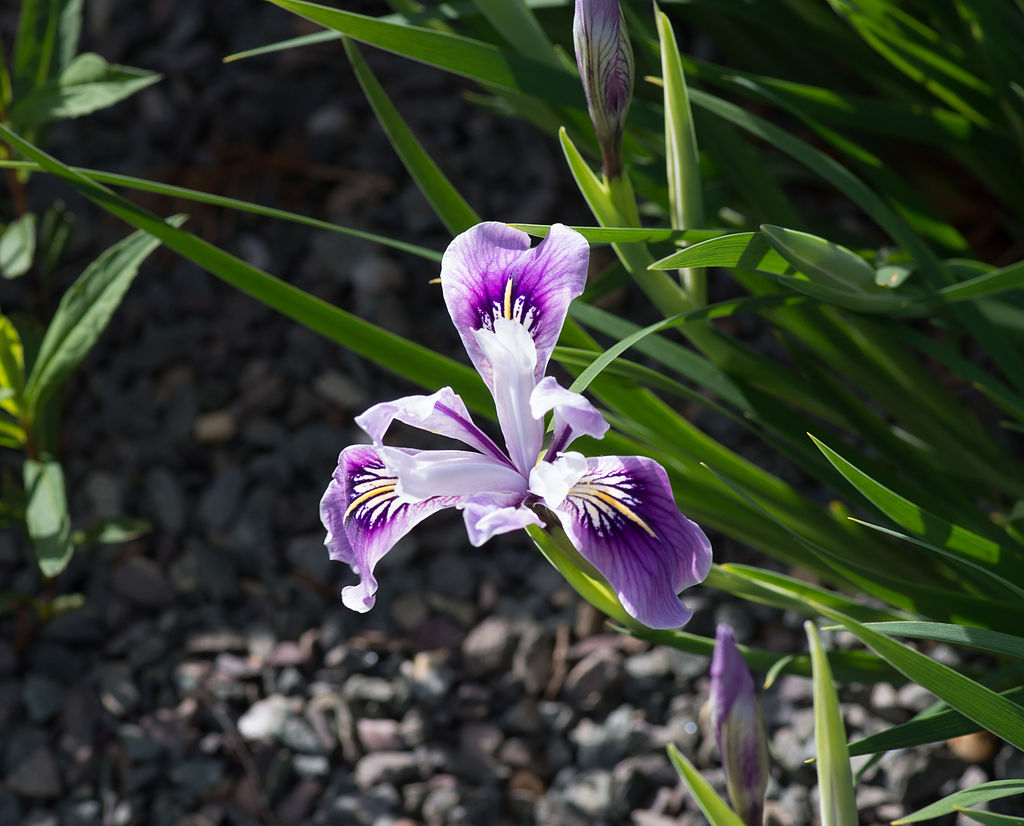 Oregon Iris – Iris tenax
Oregon Iris – Iris tenax
1 gallon – $10
At a Glance: Mainly basal, long and narrow leaves; blue to purple flowers with yellow/white highlights; flowers in May and June.
Height: up to 16 inches.
Best Growing Conditions: Mostly sunny/partial sun and wet/moist soil.
Deer Resistant? – Yes
Why Choose Oregon Iris? A beautiful native iris by itself, this iris is a great alternative to the invasive yellow flag iris along ponds and swales or even by itself as part a rain garden.
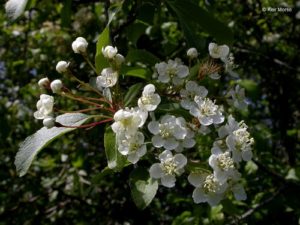
Pacific Crab Apple – Malus fusca
1 gallon – $10
At a Glance: A showy deciduous tall shrub or short tree that turns red or yellow-orange in the fall
Height: 15-40 ft
Flowers: Known for its white to pink showy fragrant apple blossoms
Fruit: Small egg shaped apples that transition from green to yellow or reddish in color. Edible fruit but a bit tart at first, the fruit mellows and becomes sweeter when allowed to age after picking.
Best Growing Conditions: Full sun to part shade with moist soils. It prefers sandy or loamy soils and does not grow well in clay soils.
Why Choose Pacific Crab Apple? A multi use plant. Pacific Crab Apples can be used both as an ornamental tree species but also a wildlife habitat feature providing foraging and shelter for a wide range of wildlife. The fruit can be eaten raw or cooked and is good source of pectin. The bark was used along or with other plant products for a variety of medicinal treatments for the eyes, stomach, and digestive tract by various tribes.
Photo copyright by Keir Morse
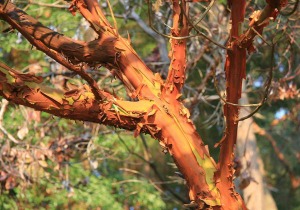 Pacific Madrone – Arbutus menziesii
Pacific Madrone – Arbutus menziesii
1 gallon – $10
At a Glance: An attractive broadleaf evergreen with a twisting reddish trunk and irregular branches with an overall rounded outline.
Height: Up to 100 feet.
Growth Form: Tree.
Stems: Young bark is chartreuse green and smooth while older bark is brownish-red with thin peeling scales.
Leaves: The alternate, evergreen leaves are dark shiny green on top and whitish-green below. Additionally leaves are hairless and have a leathery texture.
Flowers: The small pinkish-white, bell-shaped flowers are arranged in large drooping clusters and are fragrant; flowering in April.
Fruits: Small, round, orange-red berries with a finely granular texture. Berries are approximately 1 cm across and can cover the trees in productive areas.
Best Growing Conditions: dry, shallow soils in full sun. Tolerates partial shade.
Deer Resistant? – Yes
Why Choose Pacific Madrone? Beautiful broadleaf evergreen tree is attractive all year long. Supports multiple moth and butterfly species at both the larval and adult stages, and the berries are eaten by birds.
Photo by http://www.nwplants.com is licensed under a Creative Commons Attribution-ShareAlike 3.0 Unported License.
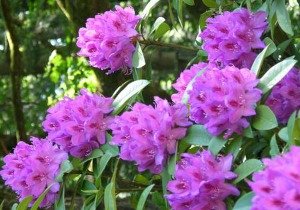 Pacific Rhododendron – Rhod. macrophyllum
Pacific Rhododendron – Rhod. macrophyllum
1 gallon – $10
At a Glance: Showy shrub that can grow very large, with clusters of large pink flowers.
Height: Up to 26 feet if grown in shade; shorter and bushier in sunlight.
Leaves: Alternate, evergreen, leathery, thick, color: deep green.
Flowers: Pink to rose-purple, bell-shaped, 5-lobed (the lobes have wavy edges), flowering in May, June, and July
Best Growing Conditions: Full sun to partly sunny; moist to dry soil.
Deer Resistant? – Yes
Why Choose Pacific Rhododendron? The clusters of eye-catching spring blooms are the main attraction. One of the showiest of our native shrubs, it adapts well to garden settings. It’s also our Washington state flower!
Photo by http://www.nwplants.com is licensed under a Creative Commons Attribution-ShareAlike 3.0 Unported License.
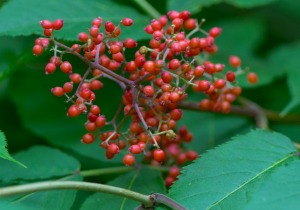 Red Elderberry – Sambucus racemose
Red Elderberry – Sambucus racemose
1 gallon – $10
At a Glance: This attractive coastal elderberry quickly reaches 5-8ft tall. The many branches arch gracefully and are amenable to pruning
Growth Form: Deciduous shrub
Flowers and Fruit: Red Elderberry has erect spikes of white flowers and bright red berries that are consumed voraciously by birds
Deer Resistant? – Yes
Best Growing Conditions: It tolerates deep shade and poor soil and likes a consistently moist site. Use this native generously under cedars or along the north edge of a pond or stream.
Photo © Joshua Mayer from www.flickr.com (License)
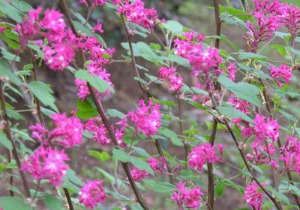 Red Flowering Currant – Ribes sanguineum
Red Flowering Currant – Ribes sanguineum
1 gallon – $10
At a Glance: Erect, multi-stemmed deciduous shrub with showy clusters of deep pink flowers in early spring.
Height: 3-10 feet
Flowers: In erect or drooping clusters of 10-20 flowers; pale pink to deep red; size: 3-10 mm long; shape: tubular. Flowers appear just prior to leaf emergence in February, March or April.
Conditions: Full to mostly sunny; dry soil.
Why Choose Red Flowering Currant? A harbinger of spring in the Pacific Northwest, blooms of Red Flowering Currant coincide with the northward migration of Rufous Hummingbirds, which follow the blooms up the Pacific Coast. Attractive to nectar-seeking insects and birds. Inedible whitish-blue berries darken to midnight blue at maturity, providing food for a variety of native birds and insects.
Photo by http://www.nwplants.com is licensed under a Creative Commons Attribution-ShareAlike 3.0 Unported License.
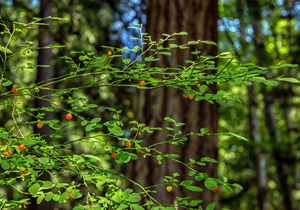 Red Huckleberry – Vaccinium parvifolium
Red Huckleberry – Vaccinium parvifolium
1 gallon – $10
At a glance: Deciduous shrub; small, white to pink urn-shaped flowers, followed by red, edible (and tasty) berries; often grows out of rotting stumps with salal.
Height: 3-12 ft., reaching taller limits in shadier conditions
Fruits: Tiny, red to orange-red, sweet-tart in flavor
Best Growing Conditions: Dry to moist soil, partial to full shade
Why Choose Red Huckleberry? Tart berries can be collected and used for pies, jams, jellies, and other confections. The berries also provide food for a wide variety of birds and mammals.
Description courtesy of www.kingcounty.gov/gonative
Photo © 2019 Paul Brians
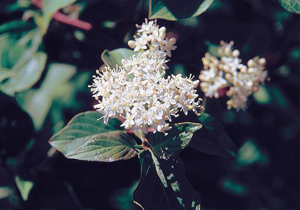 Red Twig Dogwood – Cornus sericea
Red Twig Dogwood – Cornus sericea
1 gallon – $10
At a Glance: Deciduous shrub with a rounded, spreading form. Textured green, oval leaves in the spring are a striking contrast to the colorful bark.
Height: 3-6 feet
Spread: 10-15 feet
Best Growing Conditions: Full sun to partial shade, moist to wet soil, tolerates seasonal flooding
Why Choose Red Twig Dogwood? Provides beautiful year long color interest. Best used as a screen or shrub border. Easy to grow and adaptable in a variety of settings, including seasonally flooded areas, or near drain spouts.
Photo Credits: “Cornus sericea flower” by USDA-NRCS PLANTS Database / Herman, D.E. et al. 1996. Licensed under Public Domain via Wikimedia Commons
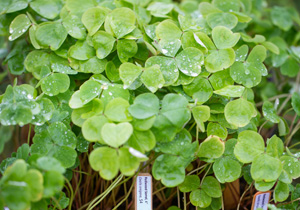 Redwood Sorrel – Oxalis oregana
Redwood Sorrel – Oxalis oregana
4″ pot – $5
At a Glance: A delicate, evergreen herb with clover-like leaves and white to pink flowers, forming carpets in forested areas.
Flowering Period: April – September
Best Growing Conditions: Mostly shady to full shade; moist to dry soil.
Deer Resistant? – Yes
Why Choose Oregon Oxalis? Since it thrives in shade and will not grow in full sun, it makes an ideal groundcover for shady areas. The leaves contain oxalic acid, which makes them a tart and tasty treat in limited quantities.
Photo © 2019 Sue Larkin
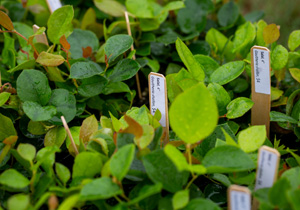 Salal – Gaultheria shallon
Salal – Gaultheria shallon
1 gal – $10
At a Glance: Creeping to erect shrub with hairy branching stems and dark leathery leaves.
Height: Up to 16 feet in exceptional cases but typically 3-7 feet tall.
Leaves: Evergreen, leathery, shiny dark green, egg shaped, 5-10 cm long.
Flowers: Occur in horizontal rows of 5-15 white-to-pinkish, urn-shaped flowers, all oriented in same direction; size: 7-10 mm long.
Flower through May, June.
Fruits: What are commonly perceived as the berries are actually fleshy parts of the flower. They are edible and sweet, but can be pithy. The true fruit is a capsule surrounded by a rounded, reddish-blue to dark purple, fleshy husk; size: 6-10 mm wide.
Conditions: Full sun to full shade; moist to dry soil.
Deer Resistant? – Yes
Why Choose Salal? One of the most common, robust, and culturally significant groundcovers of the Pacific Northwest. Use Salal under dense shade where most shrubs will not survive, or as a low-maintenance ground cover. Salal is extremely adaptable, thriving in sun, shade, humus, infertile, dry or moist soils. It requires little care once established.
Description courtesy http://www.nwplants.com/business/catalog/gau_sha.html
Photo © 2019 Sue Larkin
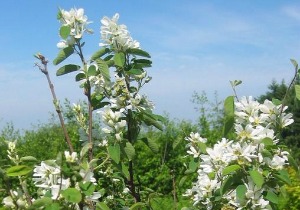 Serviceberry – Amelanchier alnifolia
Serviceberry – Amelanchier alnifolia
1 gallon – $10
At a Glance: Medium-sized shrub to small tree producing fragrant white flowers in late spring and edible berries that ripen in early summer.
Height: Up to 15 feet (4.5 meters).
Flowers: Clusters of large white flowers range from drooping to erect appear in April through May
Fruits: The edible berry-like fruits have a chocolate-blueberry-marzipan taste. Fruits start to form soon after flowers fade.
Best Growing Conditions: Full to partly sunny; Moist/Dry soil.
Why Choose Serviceberry? This handsome shrub has outstanding blue-green foliage, delicate 2” flower clusters and brilliant red and yellow fall color. The pea size, purple fruits make fantastic pies and preserves. They were highly esteemed by Native groups and used to improve the flavor of less desirable berries. Not only humans love the fruits – wildlife of all varieties will come for a taste!
Description courtesy http://www.nwplants.com/business/catalog/ame_aln.html
Photos courtesy of http://www.nwplants.com (License)
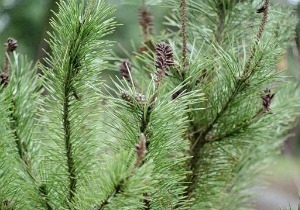 Shore Pine – Pinus contorta
Shore Pine – Pinus contorta
1 gallon – $10
At a glance: Generally a smaller to mid size tree, often sprawling and irregular in its youth and rarely achieving a full height or straight form; this pine is rather dark in color, both in leaf color and bark; needles are in pairs and tend to be shorter than many pine relatives; the small pine nuts are favored by many birds; it is one of the best pines for making unpruned hedges or visual screens; it is highly adaptable to many soil conditions, wet or dry.
Height: Usually a small tree, though it can reach 50’ with intricate branching forms.
Best Growing Conditions: Dry to wet, Full sun to partial shade
Deer Resistant? – Yes
Why Choose Shore Pine? It is fantastic in a small garden or as a hedge. A quick way to establish a native garden framework from bare ground is to plant a variety of small to large Shore pines.
Description courtesy of kingcounty.gov/GoNative
Photo ©2008 Walter Siegmund || CC-BY-SA-3.0 is licensed under a Creative Commons Attribution-ShareAlike 3.0 Unported License.
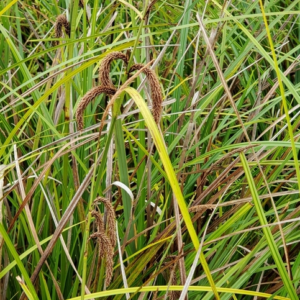 Slough Sedge – Carex obnupta
Slough Sedge – Carex obnupta
At a glance: A fast-growing evergreen perennial with attractive, densely tufted leaf clumps
Height: 1-5 feet
Diameter/Clump Size: 1-2 feet
Deer Resistant? – Yes
Leaves: Grass like, evergreen leaves that grow in dense tufted clumps and reach up to 12 inches in length. Reddish-brown tinged at base
Flowers: Yellow flowers form in groups of 3-7 on tall spikes
Why Choose Slough Sedge? Provides forage for a variety of species and habitat for waterfowl and aquatic species. Rhizomes and roots form dense mats that can be useful in bank stabilization and erosion control. Can be useful in restoring disturbed areas.
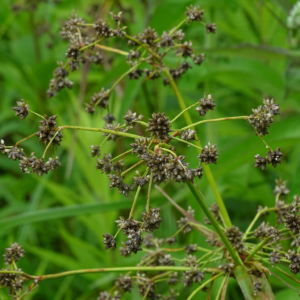 Small-Fruited Bulrush – Scirpus Microcarpus
Small-Fruited Bulrush – Scirpus Microcarpus
At a glance: Vigorously growing perennial that helps stabilize soil and does well along shorelines
Height: 2-5 feet
Diameter/Clump Size: 1-3 feet
Deer Resistant? – Yes
Leaves: Flat, grass-like leaves with reddish purple bases that clasp the stems. Sharp edges
Flowers: White, 2-inch-long clusters that appear in June – August
Best Growing Conditions: Prefers wet areas such as streambanks, wetlands, and pond edges
Why Choose Bulrush? Good habitat for nesting waterfowl. Spreads easily by rhizome and is a good choice for erosion control and revegetation of disturbed shoreline
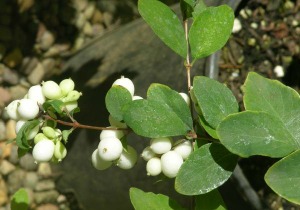 Snowberry – Symphoricarpos albus
Snowberry – Symphoricarpos albus
1 gallon – $10
At a Glance: Erect opposite-branching slighly rhizomatous shrub
Height: 3-6 ft tall and up to 6ft wide
Flowers: dense clusters of only a few pink to white bell shaped flowers on the terminal ends of branches; flowers typically 5-7mm in size (blooms in the spring and summer)
Fruit: Clusters of white, berry-like drupes that are persistent throughout the winter. The fruit is not considered particularly palatable to humans though it is popular with wildlife.
Best Growing Conditions: Prefers shade to part shade though can grow in full sun sites. Drought tolerant once established but can grow in dry to moist soils.
Deer Resistant? – Yes
Why Choose Snowberry? A great shrub for lazy gardeners, the species doesn’t get too large (requiring little to no pruning) and is ideal for bank stabilization, hedges, bird and pollinator gardens. The persistent white ‘berries’ makes it an interesting feature in the winter and wonderful color contrast in the summer and fall. In addition it is drought tolerant once established and is deer resistant.
 Spreading Rush – Juncus patens
Spreading Rush – Juncus patens
At a glance: A hardy, large-tufted, evergreen grass that tolerates seasonal flooding and poorly draining soils
Height: 1.5-3 feet
Diameter/Clump Size: 1-3 feet
Deer Resistant? – Yes
Leaves: Thin, gray green semi waxy leaves
Flowers: Brown inflorescence sprouts from side of stem rather than tip
Fruit: Red to brown spherical capsule
Best Growing Conditions: Prefers wet areas such as wetlands and marshes
Why Choose Spreading Rush? An easy to grow grass that is semi-drought tolerant once established
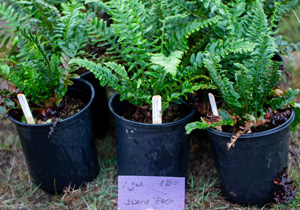 Sword Fern – Polystichum munitum
Sword Fern – Polystichum munitum
1 gallon – $10
At a Glance: A large attractive fern with erect evergreen fronds forming a circular crown.
Height: 3-5 feet (1-1.5 meters).
Leaves: Each dark green frond leaflet has a hilt-like lobe at base representing the hilt of a sword. Frond size: 3-5 ft long by 8-12 in across
Flowers: Produces spores on the underside of leaflets located halfway between the mid-vein and the margin in rows of two.
Best Growing Conditions: Mostly to full shade; moist to dry soil.
Deer Resistant? – Yes
Why Choose Sword Fern? This is a plant that will stay green through all the elements. A tall, hearty, and handsome plant of the Pacific Northwest, it makes a great addition to any garden as a background for colorful flowering plants or to add bright foliage to out-of-the-way places. A surprisingly well developed root system helps stabilize soil on slopes.
Photo © 2019 Sue Larkin
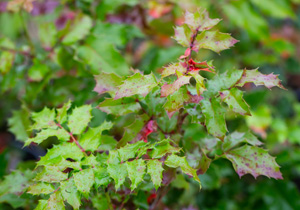 Tall Oregon Grape – Mahonia aquifolium
Tall Oregon Grape – Mahonia aquifolium
1 gallon – $10
At a glance: Evergreen shrub; has 5-9 leaflets; grows by spreading from underground roots; bright yellow clustered flowers followed by purple fruits; blooms in spring.
Height: Up to 8 ft.
Best Growing Conditions: Partial to full sun, moist to dry soil; adapted to dry, open, rocky habitats but handles shade and moisture as well.
Deer Resistant? – Yes
Why Choose Tall Oregon Grape? Rugged in appearance, it looks best planted with shorter plants around it, and holly-like leaves make it an excellent barrier hedge.
Photo © 2019 Sue Larkin
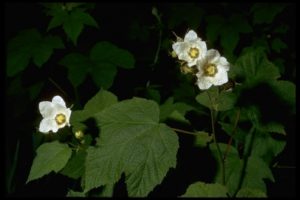 Thimbleberry – Rubus parviflorus
Thimbleberry – Rubus parviflorus
1 gallon – $10
At a Glance – A medium sized shrub known for its large maple leaf shaped soft fuzzy leaves and large raspberry like fruit.
Height – 4ft-8ft
Flowers – Relatively large (up to 1.5 inch across) simple white flowers that grow singularly or in small clusters with a pleasant fragrance
Fruit – Akin to wide shallow raspberry. When fully ripe can have texture similar to a fruit leather snack. Exact taste varies depending on growing site.
Best Growing Conditions – Prefers part shade with moist well draining soil
Why Choose Thimbleberry? The fruit of this shrub is fairly tasty and was widely collected and used as food source by multiple tribes in the region. The young shoots were also collected and eaten raw. The bark was boiled in water to make soap and the leaves were used for storage.
The shrubs themselves are fairly drought tolerant once established, requiring little to no maintenance (though they respond well to winter pruning) and are a great species for those look for a shrub to attract wildlife or birds or something along the edges of a forest or shay area. The fruit also makes a tasty treat during the summer.
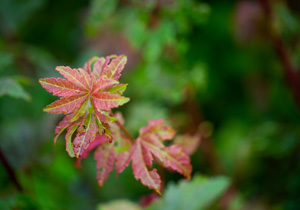 Vine Maple – Acer circinatum
Vine Maple – Acer circinatum
1 gallon – $10
At a Glance: Tall, erect, multi-trunked shrub or small tree with sprawling branches.
Height: 13-26 feet (4-8 meters)
Stems: Bark is initially smooth and bright green, eventually turning brown with age.
Leaves: Size: 5-12 cm (2-5 in) across. Leaves are green in spring; in early fall they turn orange-red or red in full sun or golden in the shade.
Flowers: Flowers grow in small loose clusters at the end of shoots, appearing May through June. Flower sepals are purple and red, hairy and spreading; petals are creamy white with purple/red highlights and can reach 6-9 mm wide
Fruits: The fruit is a two-seeded winged fruit called a samara. Size: 2-4 cm (0.8-2 in) long; color: fruits are initially green then later turn a reddish-brown.
Best Growing Conditions: Partly sunny/mostly shady; wet to moist soil.
Deer Resistant? – Yes
Why Choose Vine Maple? This elegant tree grows quickly to 10-15′ with multiple trunks and spreads to 20′ widths, much like a vine. Brilliant red and orange colors signal the arrival of autumn, while showy white flowers appear in early spring. Every bit as decorative as Japanese maples, these trees have an added bonus of providing local wildlife with food. Vine Maples like moisture and but will tolerate summer drought once established.
Description courtesy www.nwplants.com
Photo © 2019 Sue Larkin
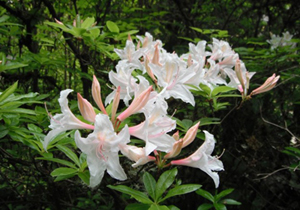 Western Azalea – Rhododendron occidentale
Western Azalea – Rhododendron occidentale
1 gallon – $10
At A Glance: One of the most stunning, native flowering shrubs in the Pacific northwest, the Western Azalea is deciduous and grows in an open form with multiple stems.
Height: Can reach 15 ft. in height but is usually 3-9 ft. tall
Flowers: Flower variations include mixtures of pale pink, deep pink, and yellow-orange.
Bloom Time: April – August
Best Growing Conditions: Moist soil, sun to shade
Deer Resistant? – Yes
Why Choose Western Azalea? Showy, fragrant white to pink flower clusters open in June through July. They are reminiscent of day lilies and emit a wonderful fragrance that travels for a considerable distance.
Photos by: Walter Siegmund, Licensed under CC BY-SA 3.0 via Wikimedia Commons and by http://www.nwplants.com under a Creative Commons Attribution-ShareAlike 3.0 Unported License.
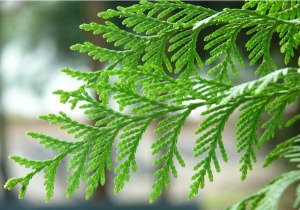 Western Red Cedar – Thuja plicata
Western Red Cedar – Thuja plicata
1 gallon – $10
At a Glance: Large conifer with branches that droop and then turn back up (J-shaped), broad crowns.
Height: 100-230 feet.
Growth Form: Tree.
Leaves: Leaves are scale-like, arranged in flat opposite pairs, overlapping shingled arrangement, die and shed after 3-4 years. Size: 2 mm long; color: yellowish-green with glossy luster.
Best Growing Conditions: thrives in moist to wet soils with part to mostly shade. Prefers nutrient-rich soils with poor drainage.
Photos: Photos by http://www.nwplants.com are licensed under a Creative Commons Attribution-ShareAlike 3.0 Unported License.
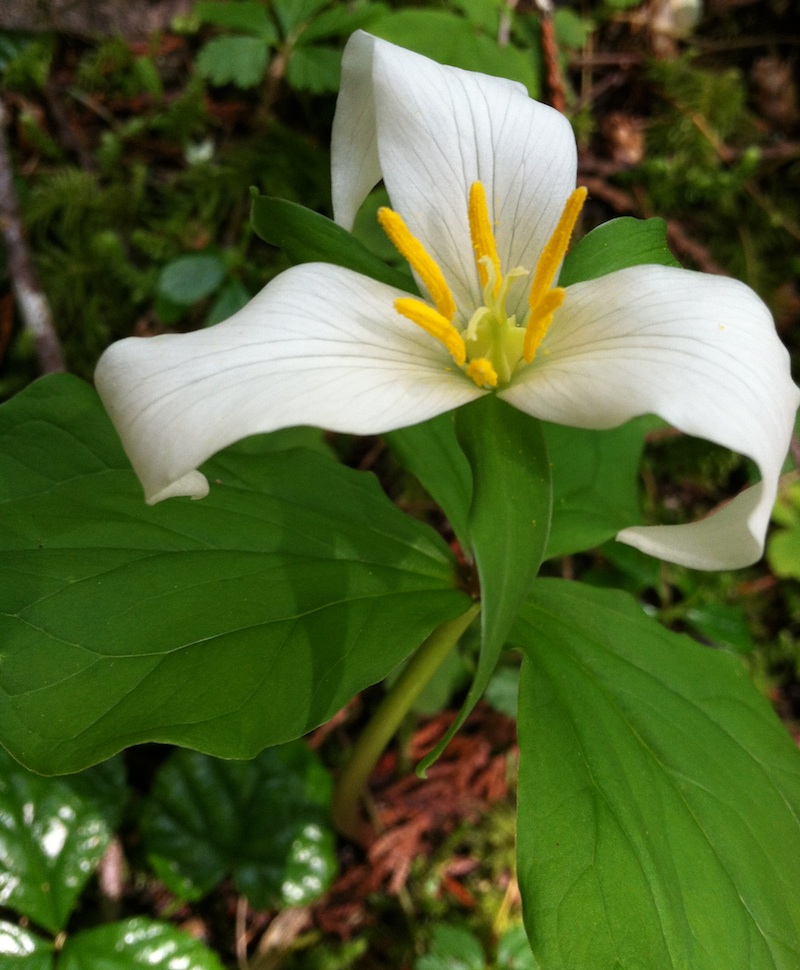 Western Trillium – Trillium ovatum
Western Trillium – Trillium ovatum
1 gallon – $10
At a Glance: Leaves are in whorls of three; leaves are unstalked; solitary flower with three white petals; flowers in March, April, and May.
Height: 12-18 inches.
Growth Form: Herb.
Best Growing Conditions: Partial sun and shade with wet/moist soil.
Photos: This image was originally posted to Flickr by Mount Rainier NPS at https://flickr.com/photos/78037339@N03/8539809399. It was reviewed on by FlickreviewR and was confirmed to be licensed under the terms of the cc-by-2.0.
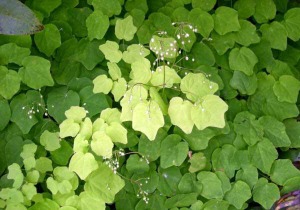 White Inside-Out Flower – Vancouveria hexandra
White Inside-Out Flower – Vancouveria hexandra
1 gallon – $10
At a Glance: Attractive duck’s foot shaped leaves and beautiful white shooting star-like flowers; spreads by rhizomes, but not a bully.
Height: 1 ft.
Growing ease: High
Best Growing Conditions: Partial shade, moist to dry soil
Deer Resistant? – Yes
Why Choose Inside-Out Flower? A delicately showy flower, V. hexandra grows well in dry, shady areas of gardens. Spreading by underground rhizomes, it will easily fill a space and is best used to fill between taller, larger plants. Keeping it on the dry side will slow its spreading pace.
Description and photo courtesy of www.kingcounty.gov/gonative